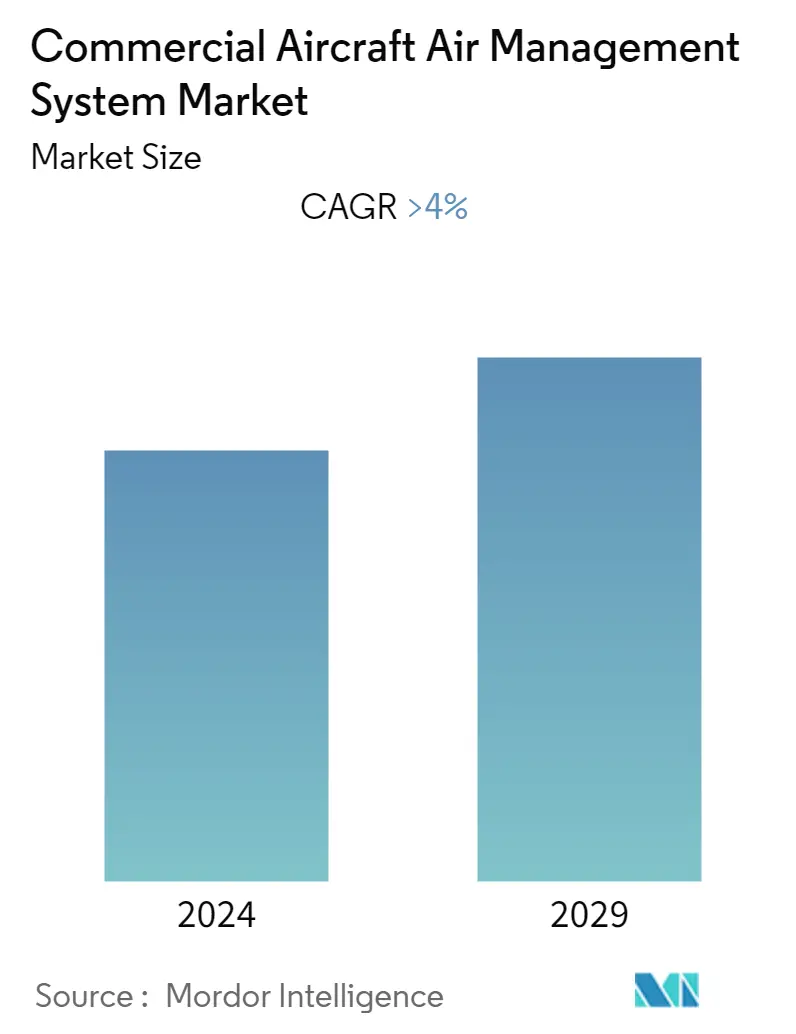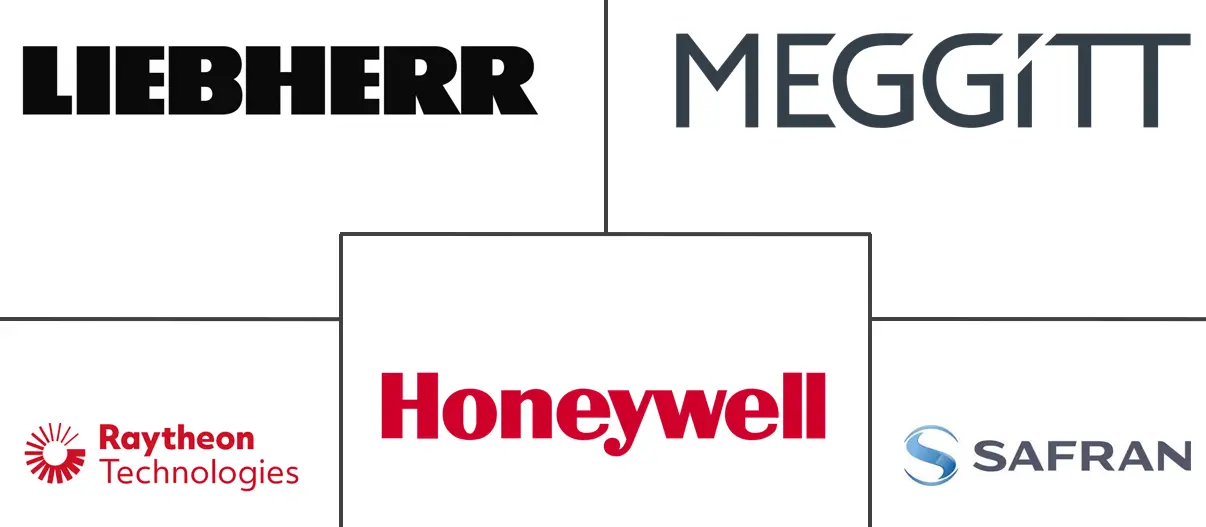Market Size of Commercial Aircraft Air Management System Industry

| Study Period | 2019 - 2029 |
| Base Year For Estimation | 2023 |
| Forecast Data Period | 2024 - 2029 |
| CAGR | > 4.00 % |
| Fastest Growing Market | Asia Pacific |
| Largest Market | North America |
Major Players
*Disclaimer: Major Players sorted in no particular order |
Commercial Aircraft Air Management System Market Analysis
The commercial aircraft air management systems market is estimated to record a CAGR of about 4.27% during the forecast period.
Due to the impact of COVID-19, the aviation industry was greatly affected globally, which led to a significant decrease in passenger traffic in 2020. This has led to a decrease in production rates of commercial aircraft programs by the aircraft OEMs and a decrease in aircraft orders and deliveries in 2020. However, the aircraft deliveries and orders witnessed a significant increase in 2021 due to the gradual recovery in passenger traffic.
The gradual recovery of passenger traffic is propelling the airlines, and aircraft operators are investing in fleet modernization initiatives and expansion of their fleet to cater to increasing routes across the various regions. This factor is propelling the market growth for commercial aircraft and, subsequently, commercial aircraft materials.
The aircraft and related subsystems industries are technology-driven. Currently, the replacement of conventional sensors with new and advanced sensors, which yield better and more accurate results, and the development of robust heat exchangers are helping the production of more efficient air management systems.
Commercial Aircraft Air Management System Industry Segmentation
The air management system plays a vital role in maintaining a comfortable environment on board an aircraft for the passengers and crew members. The system's primary functions include air conditioning and temperature control, engine bleed air, fuel tank inserting, cabin pressurization and control, ventilation, and ice protection.
The Commercial Aircraft Air Management System Market is segmented based on System, Aircraft Type, and Geography. By system, the market is segmented into thermal management system, cabin pressure control system, oxygen system, ice protection system, engine bleed air system, and fuel tank inerting system. By aircraft type, the market is segmented into narrow-body aircraft, wide-body aircraft, and regional jets. The report also covers sizes and forecasts for the market in major countries across various regions. The market sizing and forecasts for each segment have been represented based on value (USD million).
| System | |
| Thermal Management System | |
| Cabin Pressure Control System | |
| Oxygen System | |
| Ice Protection System | |
| Engine Bleed Air System | |
| Fuel Tank Inerting System |
| Aircraft Type | |
| Narrow-body Aircraft | |
| Wide-body Aircraft | |
| Regional Jets |
| Geography | |||||||
| |||||||
| |||||||
| |||||||
| |||||||
|
Commercial Aircraft Air Management System Market Size Summary
The commercial aircraft air management systems market is poised for steady growth, driven by the recovery of the aviation industry post-COVID-19. The initial downturn in passenger traffic led to a reduction in aircraft production and orders, but a rebound in 2021 spurred investments in fleet modernization and expansion. This trend is further supported by technological advancements, such as the replacement of conventional sensors with advanced alternatives and the development of robust heat exchangers, which enhance the efficiency of air management systems. The ice protection systems segment, crucial for ensuring aircraft operability in cold conditions, holds a significant market share. Innovations like Qarbon Aerospace's Helios Ice Protection System highlight the ongoing emphasis on aircraft safety and the increasing demand for advanced ice protection technologies.
Geographically, the Asia-Pacific region is expected to experience the highest growth rate, with China and India leading the charge in fleet expansion and modernization. Airlines in this region are actively replacing older aircraft models with more fuel-efficient ones, driven by the rising demand for domestic travel. Major players in the market, such as Liebherr-International Deutschland GmbH, Raytheon Technologies Corporation, Honeywell International Inc., Safran SA, and Meggitt PLC, are strengthening their market presence through strategic partnerships with aircraft OEMs. These collaborations focus on developing advanced air management systems to meet evolving market demands. Innovations like Honeywell's new generation Cabin Pressure Control and Monitoring System and Diehl Aviation's emergency oxygen generator underscore the industry's commitment to enhancing aircraft safety and efficiency.
Commercial Aircraft Air Management System Market Size - Table of Contents
-
1. MARKET DYNAMICS
-
1.1 Market Overview
-
1.2 Market Drivers
-
1.3 Market Restraints
-
1.4 Porter's Five Forces Analysis
-
1.4.1 Threat of New Entrants
-
1.4.2 Bargaining Power of Buyers/Consumers
-
1.4.3 Bargaining Power of Suppliers
-
1.4.4 Threat of Substitute Products
-
1.4.5 Intensity of Competitive Rivalry
-
-
-
2. MARKET SEGMENTATION (Market Size and Forecast by Value - USD million, 2018 - 2027)
-
2.1 System
-
2.1.1 Thermal Management System
-
2.1.2 Cabin Pressure Control System
-
2.1.3 Oxygen System
-
2.1.4 Ice Protection System
-
2.1.5 Engine Bleed Air System
-
2.1.6 Fuel Tank Inerting System
-
-
2.2 Aircraft Type
-
2.2.1 Narrow-body Aircraft
-
2.2.2 Wide-body Aircraft
-
2.2.3 Regional Jets
-
-
2.3 Geography
-
2.3.1 North America
-
2.3.1.1 United States
-
2.3.1.2 Canada
-
-
2.3.2 Europe
-
2.3.2.1 United Kingdom
-
2.3.2.2 Germany
-
2.3.2.3 France
-
2.3.2.4 Rest of Europe
-
-
2.3.3 Asia-Pacific
-
2.3.3.1 China
-
2.3.3.2 India
-
2.3.3.3 Japan
-
2.3.3.4 South Korea
-
2.3.3.5 Rest of Asia-Pacific
-
-
2.3.4 Latin America
-
2.3.4.1 Brazil
-
2.3.4.2 Rest of Latin America
-
-
2.3.5 Middle-East and Africa
-
2.3.5.1 United Arab Emirates
-
2.3.5.2 Saudi Arabia
-
2.3.5.3 Egypt
-
2.3.5.4 Rest of Middle-East and Africa
-
-
-
Commercial Aircraft Air Management System Market Size FAQs
What is the current Commercial Aircraft Air Management System Market size?
The Commercial Aircraft Air Management System Market is projected to register a CAGR of greater than 4% during the forecast period (2024-2029)
Who are the key players in Commercial Aircraft Air Management System Market?
Safran SA, Honeywell International Inc., Meggit PLC, Raytheon Technologies Corporation and Liebherr-International Deutschland GmbH are the major companies operating in the Commercial Aircraft Air Management System Market.

